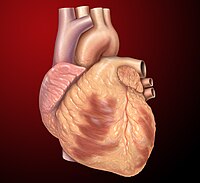
Photo from wikipedia
Background and Objectives: Cardiac amyloidosis is a disorder caused by amyloid fibril deposition in the extracellular space of the heart. Almost all forms of clinical cardiac amyloidosis are transthyretin amyloidosis… Click to show full abstract
Background and Objectives: Cardiac amyloidosis is a disorder caused by amyloid fibril deposition in the extracellular space of the heart. Almost all forms of clinical cardiac amyloidosis are transthyretin amyloidosis (ATTR) or light chain amyloidosis. 99m technetium pyrophosphate (99mTc PYP scan) has changed the landscape of the non-biopsy diagnosis of ATTR cardiac amyloidosis (ATTR-CA) by providing remarkably high diagnostic accuracy. We examined our experience with PYP scans in patients undergoing workup for ATTR-CA and evaluated the diagnostic workflow in patients with intermediate PYP scan results. Materials and Methods: Retrospective chart review study in which we analyzed data of 84 patients who underwent c-99m pyrophosphate (PYP) SPECT scan for the diagnosis of ATTR-CA from 2017 till 2021 at our institution. We identified three groups: Low uptake (PYPL uptake ratio < 1.2 + visual grade 1/0), n = 30, Intermediate uptake (PYPI uptake ratio 1.2–1.49, visual grade 2/3), n = 25 and High uptake (PYPH uptake ratio ≥ 1.5 + visual grade 2/3), n = 29. We reviewed patients’ demographics, medical histories, echo parameters and diagnostic testing including light chain analysis, cardiac magnetic resonance results, and biopsies. Results: Mean patients’ age was 73, male-to=female ratio 3:1, 59% of patients were African American. Cardiovascular comorbidities, cardiac biomarkers (BNP and Troponin) and amyloid-related neuropathy were similar in all groups. A statistically significant difference in septal thickness/posterior wall thickness and final diagnosis were found between the groups. The distribution of overall diagnostic testing ratios for the PYPI group included serum protein electrophoresis 92%, urine protein electrophoresis 65%, free light chain 80%, CMR 32%, tissue biopsy done in 20% and BM biopsy in 16%, which are similar to the ratios of other groups. Overall, 25% (n = 5, 4 TTR-CA and 1 AL Amyloid) of patients in the PYPI group had a final diagnosis of CA established with additional testing (p = 0.001 vs. other groups). Conclusions: The 99mPYP scan is an accurate noninvasive test for cardiac ATTR-CA. Importantly, 25% of the PYPI group had a final diagnosis of ATTR-CA reiterating that diagnosis needs to be pursued in PYPI cases based on clinical suspicion. Routine evaluation and exclusion of light chain disease and establishing a consistent workflow for amyloid diagnosis and continued education for technologists and readers of PYP scans is key to a successful amyloidosis workup.
Journal Title: Medicina
Year Published: 2023
Link to full text (if available)
Share on Social Media: Sign Up to like & get
recommendations!